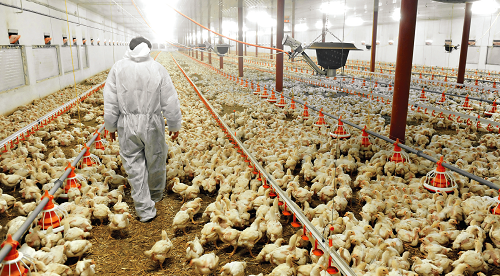Overfarming Might Increase Risk for Epidemics
The bacterial pathogen Campylobacter jejuni has developed chicken and cattle specific strains since the rise of 20th century livestock farming.

Epidemics may become more common as intensive farming techniques are utilized, according to a paper published in the Proceedings of the National Academy of Sciences (PNAS).
Investigators from the University of Bath in the UK tracked the evolution of a cattle bacterium, Campylobacter jejuni (C jejuni), in order to explain the risk and timeline for cattle adaptation for this most common enteric bacterial pathogen.
They also wanted to highlight the risks of intensive livestock production in pathogen emergence, the study authors explained.
The investigators conducted a population-genomic analysis of 1,198 C jejuni isolates that represented known diversity among the reservoir host species. The specimens came from 18 different sources—including clinical cases of campylobacteriosis, chickens, ruminants, environmental sources, pets, and wild birds—and belonged to 36 clonal complexes.
Investigators wrote that livestock accounts for 60% of all biomass on the planet and said that cattle is the most abundant of that group. C jejuni is the leading cause of gastroenteritis in high-income countries, they continued. In humans, the pathogen can cause bloody diarrhea and cause lasting in damage in those with underlying health conditions. It is resistant to antibiotics because of their use in farming, investigators wrote, and is carried in feces of chickens, pigs, cattle, and wild animals.
C jejuni strains specific to cattle emerged throughout the 20th century. Investigators wrote this coincided with the intensification of cattle farming around the world.
Once there were changes in cattle diet, anatomy and physiology, C jejuni adapted from general to cattle-specific strains, the study authors said. This helped the pathogen infect humans, too. As cattle moved around the world, so can the pathogen, investigators wrote.
“There are an estimated 1.5 billion cattle on Earth, each producing around 30 kg of manure each day; if roughly 20% of these are carrying Campylobacter, that amounts to a huge potential public health risk,” professor Sam Sheppard from the Milner Centre for Evolution at the University of Bath said in a statement. “Over the past few decades, there have been several viruses and pathogenic bacteria that have switched species from wild animals to humans: HIV started in monkeys; H5N1 came from birds; now COVID-19 is suspected to have come from bats.”
C jejuni strains even appeared to differ among livestock: there were cattle- and chicken-specific lineages, investigators found. While cattle C jejuni strains tended to display reduced hydrophobicity, chicken C jejuni strains did not. Additionally, C jejuni strains from chickens showed a higher average ability to form biofilm compared to cattle strains, but the difference was not significant, investigators wrote.
They wrote that it is likely that Campylobacter was present in some cattle throughout the entire 10,000-year history of cattle domestication. However, since the 1800s, there have been specific strains and even more so since the start of the 20th century. There was an eight-fold increase of cattle around the world between 1820-1975, investigators wrote.
“New farming techniques, improved livestock breeding, and higher stocking densities led to amplified food production, but the host population explosion and global transmission networks have also fundamentally changed the cattle niche, potentially favoring strains that are adapted to specialist lineages,” they wrote.
The team believed their work shows that environmental change in combination with increased contact with livestock can cause a rise in zoonotic pathogen infections.
“I think this is a wake-up call to be more responsible about farming methods, so we can reduce the risk of outbreaks of problematic pathogens in the future,” Sheppard concluded.
